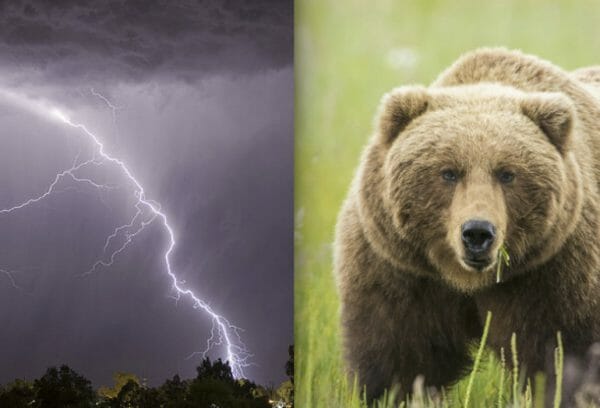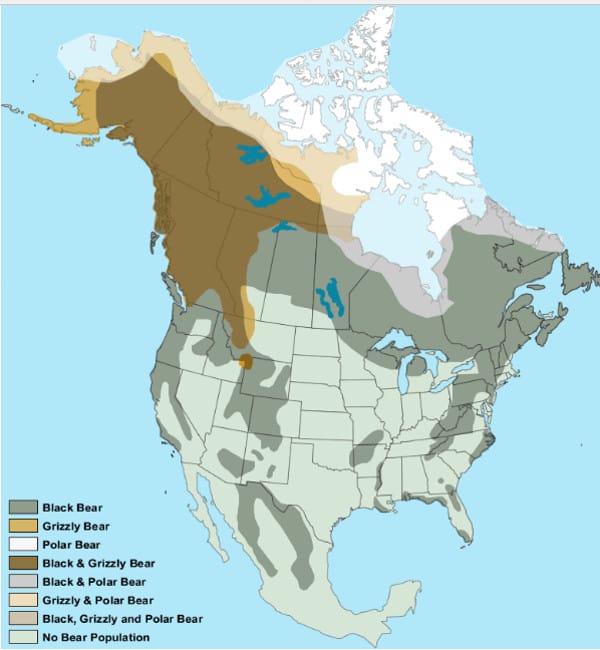
Arizona -(Ammoland.com)- In online discussions of bear attacks, it is not unusual for people to claim that a person is more likely to be killed by lightning than to be killed by a bear. That is true, in a gross sense. You are also more likely to die of a heart attack or to be murdered than to be killed by a bear when you use the entire United States population as a measure.
This comparison is disingenuous. It is easy to avoid being killed by a bear, simply by staying out of areas where there are bears. Lightning strikes occur all over the United States. Significant bear populations are limited to a fraction of the United States. The relative danger of bears and lightning depends a great deal on where you are.

I looked up lightning deaths in areas where there are significant bear populations. What I found was startling. Wyoming is rated as the most dangerous state for lightning deaths, per capita. Wyoming is also one of the top states for fatal bear attacks.
During the decade from 2004-2014, there were two deaths from lightning strikes in Wyoming. During the same period, four people were killed by bears. At least for that decade, for Wyoming, bears were twice as likely to be the cause of death as lightning. The number of people killed by bears has been rising in the last two decades, while the number of people killed by lightning is falling.
Consider Alaska. Lots of bears, and lots of lightning. But Alaska has had zero, zilch, nada people killed by lightning since 1990! During the same period, 1990 to 2014, 16 people were killed by bears in Alaska. Two more people were killed by bears in Alaska in 2017. I have not found any lightning deaths in Alaska for the period after 2014. In Alaska, people are far more likely to be killed by bears than by lightning.
While looking for bear attack information, and lightning, I came across a site from the National Park Service for Yellowstone National Park. During the period since the park was created, there have been more people killed by bears (eight) than have been killed by lightning (five). From nps.gov:
Since Yellowstone was established in 1872, eight people have been killed by bears in the park. More people in the park have died from drowning, burns (after falling into hot springs), and suicide than have been killed by bears. To put it in perspective, the probability of being killed by a bear in the park (8 incidents) is only slightly higher than the probability of being killed by a falling tree (6 incidents), in an avalanche (6 incidents), or being struck and killed by lightning (5 incidents).
In most of the United States, there are few bears, and few bear attacks, or people killed by bears. But in areas where there are lots of bears, especially grizzly bears, bears are a much greater risk than lightning, as the data from Alaska, Wyoming, and Yellowstone National Park (quite a bit of overlap with Wyoming) show.
If you are in the woods, and are confronted by a bear, the odds of an attack have increased enormously. The reason bear attacks are rare is because most people spend little time where bears are. In areas where bears are hunted heavily, most bears learn to fear humans. Bears that have lost fear of humans are very dangerous.
If you see a bear, and the bear does not run off, you may be one of the unlucky, statistical, few for whom a bear attack becomes a reality.
©2018 by Dean Weingarten: Permission to share is granted when this notice is included.
About Dean Weingarten:
Dean Weingarten has been a peace officer, a military officer, was on the University of Wisconsin Pistol Team for four years, and was first certified to teach firearms safety in 1973. He taught the Arizona concealed carry course for fifteen years until the goal of constitutional carry was attained. He has degrees in meteorology and mining engineering, and recently retired from the Department of Defense after a 30 year career in Army Research, Development, Testing, and Evaluation.
